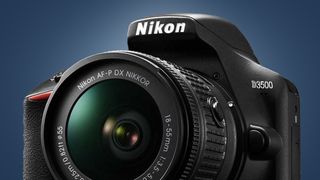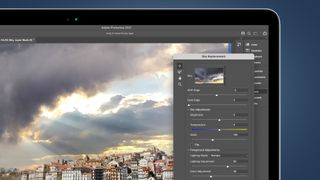Qualcomm explains why phones will soon kill off DSLRs – and it has a point
Qualcomm's predictions are hugely biased but also pretty accurate

The DSLR's death knell has been ringing on an almost daily basis for the past couple of years – and now Qualcomm has joined the fray by explaining the specific reasons why it thinks phone cameras will soon kill off the aging camera format.
In an in-depth interview with Android Authority, Qualcomm's vice-president of product management for cameras Judd Heape laid out the reasons why smartphones will soon consign DSLRs to history. And the chip maker's slightly biased vision is pretty compelling, particularly given the recent drop in third-party DSLR lens options.
As you'd expect from one of the world's biggest chip makers, Qualcomm's predictions center around image processing. "The processing in Snapdragon is 10 times better than what you can find on the biggest and baddest Nikon and Canon cameras," claimed Judd Heape. "And that’s why we’re able to really push the barrier on image quality. Because even though we have a small lens and small image sensor, we’re doing many, many times more processing than what’s even capable in a DSLR," he added.

This is certainly true, and has been for some time. The question for many photographers is how much processing is acceptable in their photos – after all, we're reaching a point where interpolation and AI edits are starting to comprise the majority of a smartphone photo. And for many traditionalists, even those who happily adjust their snaps in digital post-processing, that's crossing a line.
But this is a separate discussion from the death of DSLRs. There's no doubt DSLRs, which are distinct from mirrorless cameras due to their optical viewfinders, have been on a dramatic slide.
Yes, DSLR sales got a small bump in a positive direction earlier this year, with shipments up 131.8% year-on-year in May (according to CIPA stats), but that was down to components shortages for mirrorless cameras. The bigger picture is that DSLRs are in terminal decline – and that process has been expedited as much by camera manufacturers as smartphones.
Trust the process
High-end mirrorless cameras are under no imminent threat from smartphones. No amount of AI processing can replicate the quality and reach of, say, a Canon EOS R5 and a super-telephoto lens. That's also true of DSLRs, but their continued survival (at least on the production line) looks unlikely for a variety of reasons, including the key one outlined by Qualcomm.
Get daily insight, inspiration and deals in your inbox
Get the hottest deals available in your inbox plus news, reviews, opinion, analysis and more from the TechRadar team.
The unofficial abandonment of DSLRs by Canon and Nikon – we haven't seen a new one launch from either since early 2020 – has left them in a processing dark age. This has left them out in touch when it comes to modern features like video and AI subject recognition – and it's this area where Qualcomm rightly thinks the schism will grow between phones and DSLRs.

"We will have announcements very soon where we’re gonna have dedicated hardware to handle different parts of the scene," Judd Heape told Android Authority. "Hardware to know what to do for pixels that are skin, versus hair, versus fabric, versus sky, versus grass, versus background. Those are the areas – and again those all apply to video – where we really see the need to add specific hardware," he added.
This isn't an entirely new concept. Current phones and mirrorless cameras can do broad subject recognition, for example recognizing animals and skies. But as Qualcomm explains, this will soon go to the next level – and will crucially happen in real-time.
As Judd Heape explained: "Imagine a world from the future where you’d say ‘I want the picture to look like this National Geographic scene,’ and the AI engine would say ‘okay, I’m going to adjust the colors and the texture and the white balance and everything to look like and feel like this image you just showed me’".
It's a compelling prospect, if one that definitely won't appeal to all photographers.
Out in the cold
None of this instantly makes DSLRs bad cameras. For a traditional, cleaner shooting experience with minimal processing, the best DSLRs remain some of the best-value photographic tools around – particularly when you combine them with high-quality glass.
But when it comes to the point-and-shoot experience, the computational photography revolution is still unfolding. Phones will continue to be at the forefront. but mirrorless cameras will increasingly adopt similar tricks for different purposes. For example, Sony's next-gen flagships will likely contain even more powerful subject recognition, which will be used for autofocus tracking rather than instant photo processing.

With the camera industry absorbing declining sales over the last few years, and DSLRs only comprising 18% of its profits (compared to 69% for mirrorless cameras, according to recent CIPA figures), something has to give – and that will likely be the production of DSLRs and their lenses.
As Petapixel points out, the number of third-party lenses for Nikon and Canon DSLRs has fallen dramatically, with key players Tamron and Sigma behind many of the chops. And while smartphones have certainly played a role in this decline, particularly in the entry-level space, the death of the DSLR is as much about the camera industry's shift to mirrorless tech as AI processing. And it's here that standalone cameras will more than hold their own against the best phone cameras.

Mark is TechRadar's Senior news editor. Having worked in tech journalism for a ludicrous 17 years, Mark is now attempting to break the world record for the number of camera bags hoarded by one person. He was previously Cameras Editor at both TechRadar and Trusted Reviews, Acting editor on Stuff.tv, as well as Features editor and Reviews editor on Stuff magazine. As a freelancer, he's contributed to titles including The Sunday Times, FourFourTwo and Arena. And in a former life, he also won The Daily Telegraph's Young Sportswriter of the Year. But that was before he discovered the strange joys of getting up at 4am for a photo shoot in London's Square Mile.
